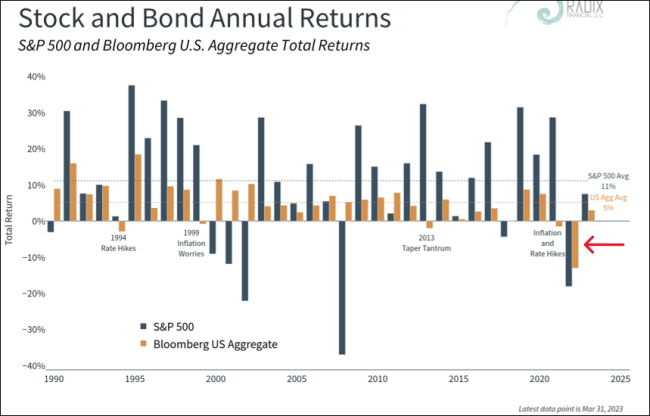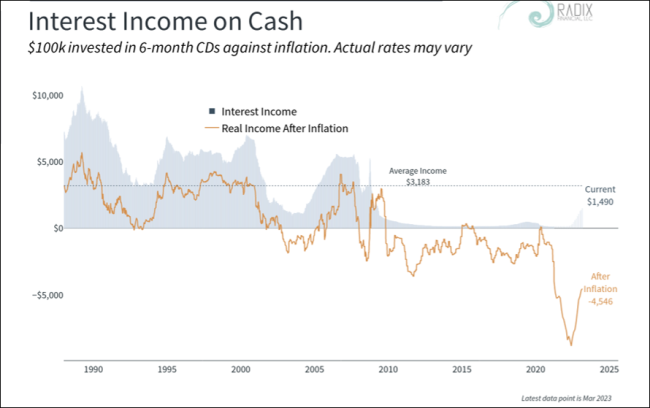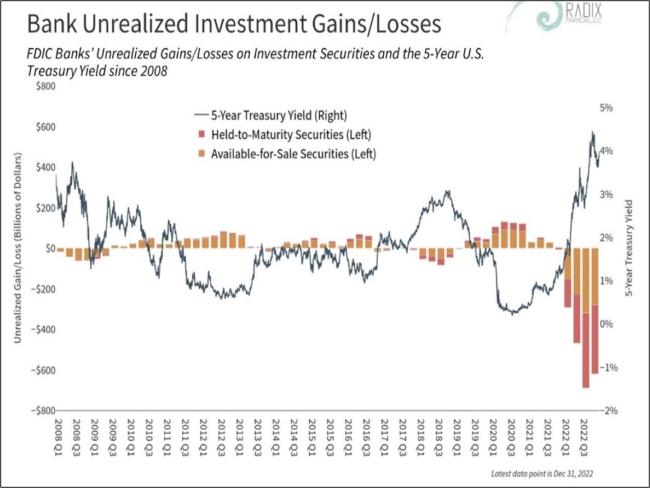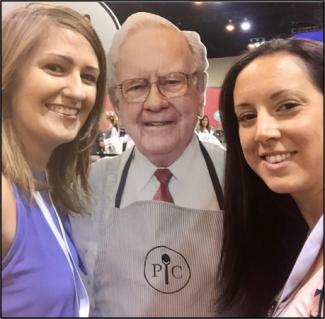
The Fed is Breaking Things
Happy Spring! The flowers are blooming and the markets are up!
It's easy to get discouraged by the renewed cycle of headline bad news; but historically, by the time a recession finally hits the real economy, the capital markets have already reacted, recalibrated, and begun to recover. So from our perspective, we're seeing long-term opportunities everywhere. To quote Warren Buffett:
“No matter how great the talent or efforts, some things just take time. You can’t produce a baby in one month by getting nine women pregnant.”
No recovery is a straight line up, but while we continue to see volatility across global markets, the key differentiator for the first quarter relative to 2022 is that the volatility has not been solely showcased to the downside. January started out strong for equity and bond markets alike, continuing its long road to recoup the losses posted in ’22. The trend reversed to the downside in February as inflation remained stubbornly high.
Then there was March. Amazingly, the major large cap equity and bond markets finished with positive returns for the month, despite experiencing the largest banking failure since the 2008 Global Financial Crisis (more on that below). The S&P 500 is up 7% through the first quarter, led by the tech sector, and the MSCI EAFE (International ex US) index is up 7.6%. Bonds were largely positive, with the Barclays US Aggregate index posting a 3% return for the quarter. So will we finally see this recession everybody keeps talking about in Q2? We don’t think so, but as the SVB bank debacle clearly illustrated, Fed action is finally starting to break things.
Banking 101
To set the stage for a discussion of what happened with the banks, we first have to understand how banks work (or how they're supposed to). Banks take deposits from consumers in the form of checking accounts, savings accounts, money market accounts, and CDs. They then take those deposits and lend them out or invest in securities like US Treasuries. In the US, the Federal Reserve and the FDIC mandate what amounts banks must keep on “reserve” to meet deposit redemption requests. (Sidenote: since March of 2020, that reserve requirement has been…0%.) But the key is, by the very nature of banks, not all depositors can demand their money back at once, because the money has either been invested or lent to others. It's why FDIC insurance was created, to give comfort and prevent “bank runs” like we just saw occur at Silicon Valley Bank (SVB).
So what went wrong? Four big things:
Catalyst #1 – Unique lending exposure and high uninsured deposits relative to other banks
"It's a business that can be a very good business, when run right. There's no magic to it. You just have to stay away from doing something foolish. It's a little like investing. You don't have to do anything very smart. You just have to avoid doing things that are ungodly dumb." – Warren Buffett (on banks)
Silicon Valley Bank specialized in lending to venture capital-backed tech start-ups. Meaning that their deposit base, compared to the average US bank, was skewed much higher to business and private equity banking. Because of covenants in their lending agreements, they also required a high proportion of the collateral for their lending to be kept on deposit. Which all led to SVB holding a higher proportion of uninsured deposits, 93.8% compared to a national average of about 45%.
Catalyst #2 –Unhedged US Treasury securities
“There is no such thing as a 100% sure thing when investing. Thus, the use of leverage is dangerous. A string of wonderful numbers times zero will always equal zero. Don’t count on getting rich twice.” – Charlie Munger
Remember that banks make their profit on the spread between what rate they pay to depositors and what rate they lend at. In recent history, cash deposits have yielded 0% and reserve cash was leveraged to purchase US Treasury securities at around 1.8%. So even at historically low rates, the banks were still making money. It’s a common and normal practice; however, while US Treasuries are backed by the full faith and credit of the US government and effectively credit risk-free, they are still subject to interest rate risk.
Bond prices and interest rates have an inverse relationship, so as rates rise, prices fall – and vice versa. Bizarrely, no one at SVB bothered to hedge the risk of rising interest rates, and as we know, interest rates were ratcheted up aggressively in the last year. So, while these US Treasuries held no risk of default if held to maturity, their unhedged mark-to-market prices plummeted with the rest of the bond market, which experienced the biggest loss in 30 years (see chart below). A big problem only if you’re forced to sell them prior to maturity to meet unexpectedly high deposit redemption demand.
Catalyst #3 – Competition for cash yield
“Show me the incentive, and I’ll show you the outcome.” - Charlie Munger
Rising interest rates are good for lenders and savers but bad for borrowers and spenders. Where formerly the incentive existed to borrow (at low rates), the tables quickly turned, and bank interest yields failed to keep pace with inflation and the increase in short-term Treasury yields. For SVB’s cash dependent start-up customer base, a contracting economy and high inflation put strain on their business cash needs and made further borrowing (if they could get it) more expensive. What that meant for SVB and many other banks, is a period of unusually high outflows of cash deposits either to fund ongoing business expenses or into competitive short-term investment securities, which are suddenly yielding 5.0% as compared to bank cash yields still close to 0%.
Catalyst #4 – Fear
“After all, you only find out who is swimming naked when the tide goes out.” – Warren Buffett
SVB had a coveted loan portfolio, high margins on lending, and served as an important lubricant to American innovation. It’s a cautionary tale, but it could happen to any bank. When a higher-than-expected number of depositors needed their money back, the Treasury securities had to be sold at a loss, to meet redemptions. The equity investors in SVB did not like this at all, and their stock fell by 60% on Thursday March 9th. Even then, the bank itself was still solvent ̶ that is until billionaire fund manager Peter Thiel lit the pyre by publicly suggesting that companies in their portfolios move their money somewhere safer. The race was on, as depositors clamored to withdrawal $42 billion in cash, a quarter of the bank’s deposits, before it was too late. By Friday afternoon, the bank was deemed insolvent and turned over to the FDIC. Signature Bank, another specialized bank with heavy exposure to crypto, was washed up in the contagion and taken over by the Fed over the weekend. Credit Suisse, notorious for its lower quality lending practices, was forced to merge with Swiss competitor UBS a week later.
Tell me more about the FDIC
“Rule number one: Never lose money. Rule number two: Never forget rule number one.” – Warren Buffett
The US FDIC insurance program is designed to prevent bank runs by providing peace of mind for depositors in regulated banks in the United States. The current amount of FDIC insurance for depositors is $250,000 USD (per bank). The last time we saw an increase was in 2008, in response to the last time we had a banking crisis. It’s not about the amount, that’s arbitrary. The FDIC is not designed to ever pay out, rather it’s a construct to inspire consumer confidence in private US banking institutions. If your money is insured by the FDIC, it doesn’t matter if your bank fails; your money is guaranteed by Uncle Sam and there is no reason for a bank run.
But in this case, over 90% of SVB’s deposit accounts were over $250,000; and therefore, “uninsured.” Imagine that you had a $100 million house, but it was only insured for $250,000. If it burns down, you’re screwed, which is why there was a run on SVB the moment depositors smelled smoke. But with a novel move, the FDIC, in an effort to save the neighborhood, pledged to insure all deposits of both SVB and Signature Bank, which effectively sets a precedent that any other bank failures will also be covered.
And thus ended the great banking crisis of March 2023…at least in the United States.
Now what?
“The most important thing to do if you find yourself in a hole is to stop digging.” – Warren Buffett
Whether you agree or disagree in principle with the implied full deposit insurance now offered by the FDIC, it has had the desired effect. It put an immediate stop to the threat of other bank runs in the sector, as SVB is not the only bank to be underwater on reserves. The below chart illustrates just how severe the liabilities in investment securities are in response to the increase in rates. The FDIC backstop will allow time for those securities to mature, and for banks to become competitive on their deposit rates.
But there will still be consequences. We can only guess at the extent, but these are some we feel are likely:
- FDIC limits will be raised arbitrarily, probably to $500,000;
- Higher interest on deposits – When investors can simply buy a US Treasury bill for 5%, there is no reason to keep excess cash sitting in the bank or within a bank CD. If banks expect to keep deposits, they’re going to have to start paying interest again. Good news for consumers; and
- Bank regulations will be increased, increasing regulatory costs on smaller niche and community-based banks. The result will be that the big banks will get bigger and lending will be tightened, adding to the growing headwinds of leverage-heavy industries like Real Estate.
How does this affect me, my money, and my investments with you?
“Risk comes from not knowing what you’re doing.” – Warren Buffett
As investment advisors, we are not FDIC insured. We do not take custody of your funds, commingle your funds with our corporate funds, nor lend out your funds to anyone else. Your accounts are “insured” by the diversified investments you hold, and they would not be affected if our company were to fail (it isn't).
We do hold a small proportion (generally 5%) of your account balance in cash at qualified US custodial banks. These amounts are insured by SIPC at the same levels as the FDIC. If however, you hold cash at a US bank in excess of FDIC or SIPC limits, we would suggest diversifying. We would also never recommend you hold any excess cash beyond what is needed for short-term spending in a Caribbean-based bank, as these balances are not insured and it is unlikely that government would have the wherewithal to step in and guarantee depositors in the case of a run.
Let us know if you would like to discuss cash management options. In response to increased demand for low volatility income-based investment exposure, we are excited to announce the launch of our First Pillar Income Reserve strategy in Q2. More details to follow in the coming weeks!
Changes to the Global Growth Portfolio
“Life, in part, is like a poker game, wherein you have to learn to quit sometimes when holding a much-loved hand – you must learn to handle mistakes and new facts that change the odds.” – Charlie Munger
In May of 2018, Jessica and I flew to Omaha, Nebraska, for the Berkshire Hathaway annual shareholders meeting, an event commonly referred to as “Woodstock for Capitalists.” For finance nerds, it is a bucket list pilgrimage, and with Warren and Charlie in their nineties, we did not want to miss the opportunity to say we’d done it. It did not disappoint. This was the year that Charlie Munger infamously compared cryptocurrency to “trading turds.” Classic.
Five-ish years and 129% upside return later, we made the decision to exit our long-standing position in Berkshire Hathaway (BRK.B) within our core portfolio. Our decision was primarily due to concerns about the increased overlap in holdings of the Berkshire portfolio of companies with the Radix core. Most concerning was the fact that Berkshire’s position in Apple Inc. (AAPL, also a Radix holding) had reached nearly 41%. Other significant overlapping positions include Chevron (CVX), Activision Blizzard (soon to be acquired by Radix holding, Microsoft), General Motors, Visa, and Amazon.
Moreover, while we retain the utmost respect for Warren (age 92) and Charlie (age 99), the lack of a clear succession plan is worrying. With any company whose founder is so inextricably tied to a company, we would expect the market to have strong negative reaction to the passing of either, as any fan of the HBO show Succession can tell you.
As a replacement for the position, we purchased shares of Broadcom Inc (AVGO), a well-capitalized and well managed semiconductor manufacturer. President and CEO, Hock Tan, has been managing the company since 2006, building it into the quality late-stage growth company that it is today. With net margins of 35%, a dividend of over 3% (with consistent increases) and a beta of only 1.11, the company seems to be a rare unicorn within the tech sector.
Within fixed income, we tactically reduced the overweight position to short-term bonds by eliminating short-term corporate exposure. Exposure was re-allocated to broad international bonds. We continue to believe we are approaching the end of the Fed’s rate hike cycle and, with lower interest rate risk expectations, are comfortable extending exposure further out along the curve.
Within equities, we slightly increased large cap developed market (ex-US) exposure. Funds were allocated from US large cap exposure, in hopes to capitalize on more favorable valuations after a strong run-up in US equities in January and to better align with the exposures of the MSCI All Country World Index.
Final Word
“Find a very smart high-grade partner – preferably slightly older than you – and then listen very carefully to what he (she) says." – Warren Buffett
In ode to our investing heroes, we’ve woven in some nuggets of wisdom from the very best throughout this quarter’s letter. Call it hokie or cliché but Warren Buffett and Charlie Munger’s career performance record, commitment to long-term discipline, passion for their company, each other, and their shareholders demands our esteem.
As always, thank you for reading, we hope it’s both educational and entertaining.
Be well and #knowyourworth
Amy Hubble & Jessica Jablonowski





